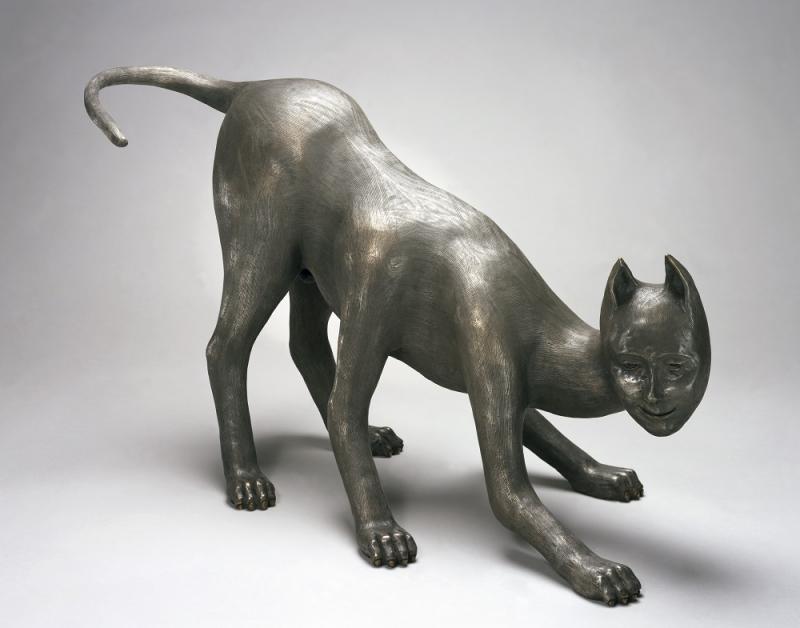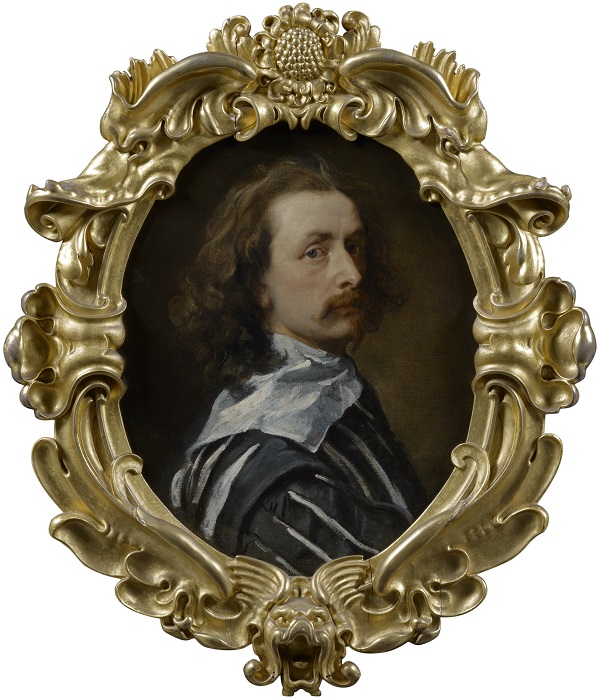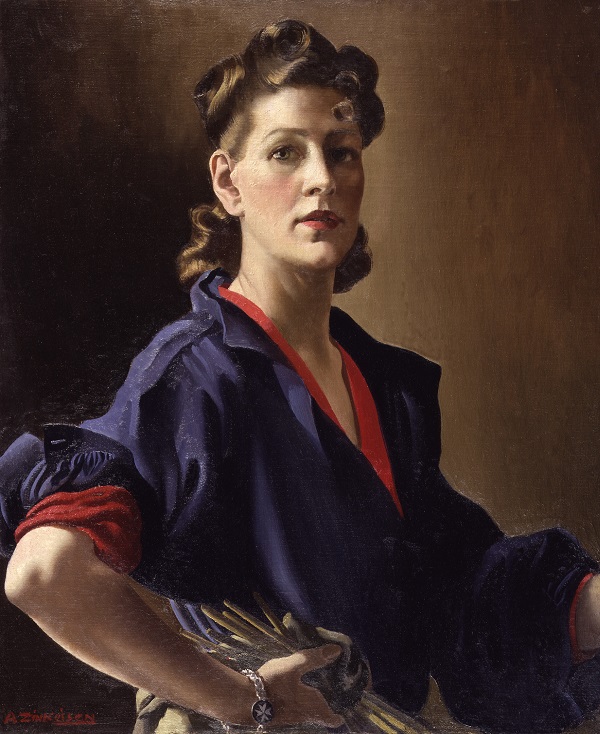Self: Image and Identity, Turner Contemporary | reviews, news & interviews
Self: Image and Identity, Turner Contemporary
Self: Image and Identity, Turner Contemporary
Is Van Dyck really the father of the self-portrait?

It seems only right that Sir Anthony Van Dyck’s last Self-portrait, 1640-1 (pictured below right), saved for the nation last year as a result of a very public campaign, should now embark on a tour of the country as much in recognition of the 10,000 or so individuals who contributed to its purchase fund, as of its significance to British portraiture.
 The narrative is an unashamedly celebratory one, and for the most part it holds up well, helped along by plentiful and varied examples of Van Dyck’s influence from the 17th century to the present day. The self-portrait is not a big painting, but its modest proportions belie the immense self-assurance, perhaps even arrogance of Van Dyck, who rejected the relative anonymity and craftsman status normally afforded to artists, in favour of unprecedented celebrity.
The narrative is an unashamedly celebratory one, and for the most part it holds up well, helped along by plentiful and varied examples of Van Dyck’s influence from the 17th century to the present day. The self-portrait is not a big painting, but its modest proportions belie the immense self-assurance, perhaps even arrogance of Van Dyck, who rejected the relative anonymity and craftsman status normally afforded to artists, in favour of unprecedented celebrity.
Van Dyck’s costume is that of a courtier, not a lowly servant, and the very act of painting his own portrait, appropriating a form reserved for the aristocracy, is one of self-aggrandisement. And yet this is very much the self-portrait of an artist, his right arm raised slightly as if holding a brush, his gaze as much an artist’s scrutiny of his subject, as a sitter’s acknowledgement of the viewer. There remains some question as to whether the painting is finished, but it is surely rather beguiling to think of the contrast between the exquisitely painted face and the looser, more expressive brushstrokes of the drapery as a commentary on the business of painting itself.
The influence of the painting was keenly felt and it finds an echo in the image of court portraitist Sir Godfrey Kneller, 1685, who nevertheless glances over his shoulder rather stiffly, compared to Van Dyck, lacking his elegance and lightness of touch. Even in the 20h century, this mode of self-portraiture persisted, with the sisters Doris and Anna Katrina Zinkeisen each conveying a strong, but distinct artistic persona that reflects the social fabric of the time as much as the individual concerns of each woman.
The society portraitist Doris Zinkeisen aligns herself with her clientele, her lavish painting from the 1920s serving not only as an advertisement, but as evidence of her own elevated social position. Her sister’s image, from circa 1944, engages a very different sensibility; Anna’s use of the graphic style and visual lexicon of wartime posters, her rolled-up sleeves and her brushes slung under her arm like tools, very forcefully reject the label of "lady painter" (Pictured below: Anna Katrina Zinkeisen, Anna Katrina Zinkeisen, c. 1944).
 Gender has continued to be fertile ground for artists exploring their own identity, and for Margate’s own Tracey Emin, the autobiographical takes centre-stage. The inclusion of Emin's film, Why I Never Became a Dancer, 1995, introduces a heightened sense of place, a powerful ingredient here on the windswept shores of north Kent, and one that is brought to bear again with the inclusion of Whitstable artist Jeremy Millar’s Self-portrait as a Drowned Man (The Willows), 2011, and perhaps even Turner’s excruciatingly self-conscious watercolour of himself as a teenager.
Gender has continued to be fertile ground for artists exploring their own identity, and for Margate’s own Tracey Emin, the autobiographical takes centre-stage. The inclusion of Emin's film, Why I Never Became a Dancer, 1995, introduces a heightened sense of place, a powerful ingredient here on the windswept shores of north Kent, and one that is brought to bear again with the inclusion of Whitstable artist Jeremy Millar’s Self-portrait as a Drowned Man (The Willows), 2011, and perhaps even Turner’s excruciatingly self-conscious watercolour of himself as a teenager.
The British bias that results from the high proportion of National Portrait Gallery loans emphasises the rapid development of the artist's self -portrait in this country. The NPG's earliest example of an English self-portrait, a miniature dating from some 80 years before the Van Dyck and made more as a token of friendship than an artistic statement, makes a striking contrast with Van Dyck's subtle and multi-layered deployment of his own image.
And yet having built for Van Dyck this persuasive and impressive pedestal, the curators have set about undermining it in the most curious fashion. By including artists like Louise Bourgeois and Andy Warhol, who really cannot comfortably be absorbed into the narrative of British art, the absence of work by consummate self-portraitists like Rembrandt and Dürer suddenly becomes problematic, causing the whole edifice to wobble. By extending its range from British to international, the show's driving principle, which casts Van Dyck as the father of the self-portrait, loses focus and a degree of credibility.
Explore topics
Share this article
The future of Arts Journalism
You can stop theartsdesk.com closing!
We urgently need financing to survive. Our fundraising drive has thus far raised £49,000 but we need to reach £100,000 or we will be forced to close. Please contribute here: https://gofund.me/c3f6033d
And if you can forward this information to anyone who might assist, we’d be grateful.

Subscribe to theartsdesk.com
Thank you for continuing to read our work on theartsdesk.com. For unlimited access to every article in its entirety, including our archive of more than 15,000 pieces, we're asking for £5 per month or £40 per year. We feel it's a very good deal, and hope you do too.
To take a subscription now simply click here.
And if you're looking for that extra gift for a friend or family member, why not treat them to a theartsdesk.com gift subscription?
more Visual arts
 'We are bowled over!' Thank you for your messages of love and support
Much-appreciated words of commendation from readers and the cultural community
'We are bowled over!' Thank you for your messages of love and support
Much-appreciated words of commendation from readers and the cultural community
 Photo Oxford 2025 review - photography all over the town
At last, a UK festival that takes photography seriously
Photo Oxford 2025 review - photography all over the town
At last, a UK festival that takes photography seriously
![SEX MONEY RACE RELIGION [2016] by Gilbert and George. Installation shot of Gilbert & George 21ST CENTURY PICTURES Hayward Gallery](https://theartsdesk.com/sites/default/files/styles/thumbnail/public/mastimages/Gilbert%20%26%20George_%2021ST%20CENTURY%20PICTURES.%20SEX%20MONEY%20RACE%20RELIGION%20%5B2016%5D.%20Photo_%20Mark%20Blower.%20Courtesy%20of%20the%20Gilbert%20%26%20George%20and%20the%20Hayward%20Gallery._0.jpg?itok=7tVsLyR-) Gilbert & George, 21st Century Pictures, Hayward Gallery review - brash, bright and not so beautiful
The couple's coloured photomontages shout louder than ever, causing sensory overload
Gilbert & George, 21st Century Pictures, Hayward Gallery review - brash, bright and not so beautiful
The couple's coloured photomontages shout louder than ever, causing sensory overload
 Lee Miller, Tate Britain review - an extraordinary career that remains an enigma
Fashion photographer, artist or war reporter; will the real Lee Miller please step forward?
Lee Miller, Tate Britain review - an extraordinary career that remains an enigma
Fashion photographer, artist or war reporter; will the real Lee Miller please step forward?
 Kerry James Marshall: The Histories, Royal Academy review - a triumphant celebration of blackness
Room after room of glorious paintings
Kerry James Marshall: The Histories, Royal Academy review - a triumphant celebration of blackness
Room after room of glorious paintings
 Folkestone Triennial 2025 - landscape, seascape, art lovers' escape
Locally rooted festival brings home many but not all global concerns
Folkestone Triennial 2025 - landscape, seascape, art lovers' escape
Locally rooted festival brings home many but not all global concerns
 Sir Brian Clarke (1953-2025) - a personal tribute
Remembering an artist with a gift for the transcendent
Sir Brian Clarke (1953-2025) - a personal tribute
Remembering an artist with a gift for the transcendent
 Emily Kam Kngwarray, Tate Modern review - glimpses of another world
Pictures that are an affirmation of belonging
Emily Kam Kngwarray, Tate Modern review - glimpses of another world
Pictures that are an affirmation of belonging
 Kiefer / Van Gogh, Royal Academy review - a pairing of opposites
Small scale intensity meets large scale melodrama
Kiefer / Van Gogh, Royal Academy review - a pairing of opposites
Small scale intensity meets large scale melodrama
 Jenny Saville: The Anatomy of Painting, National Portrait Gallery review - a protégé losing her way
A brilliant painter in search of a worthwhile subject
Jenny Saville: The Anatomy of Painting, National Portrait Gallery review - a protégé losing her way
A brilliant painter in search of a worthwhile subject
 Abstract Erotic, Courtauld Gallery review - sculpture that is sensuous, funny and subversive
Testing the boundaries of good taste, and winning
Abstract Erotic, Courtauld Gallery review - sculpture that is sensuous, funny and subversive
Testing the boundaries of good taste, and winning
 Edward Burra, Tate Britain review - watercolour made mainstream
Social satire with a nasty bite
Edward Burra, Tate Britain review - watercolour made mainstream
Social satire with a nasty bite

Add comment